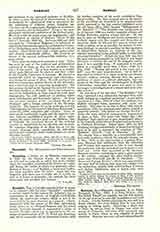

Rambler, the, a Catholic periodical (not of course to be confused with the older “Rambler“, published a century earlier by the famous Dr. Johnson), has an importance in the history of English Catholicism during the nineteenth century which is not to be measured by its mere duration as a journal. Closely associated with the names of Sir John (afterwards Lord) Acton (q.v.), Richard Simpson and, for a brief period, Newman himself, it represented a phase of convert thought which was in opposition to the extreme ultramontanism of W. G. Ward and Manning, and which eventually led to increasing friction with the leading members of the newly established English hierarchy. The chief external facts in the history of the periodical are recounted in an announcement which appeared in the last number published under the old name (May, 1862) headed “Enlargement of the `Rambler‘”: “The Rambler was commenced on 1st of January 1848 as a weekly magazine of home and foreign literature, politics, science and art. Its aim was to unite an intelligent and hearty acceptance of Catholic dogma with free enquiry and discussion on questions which the Church left open to debate and while avoiding, as far as possible, the domain of technical theology, to provide a medium for the expression of independent opinion on subjects of the day, whether interesting to the general public or especially affecting Catholics”. Before the year 1848 was over the new venture succeeded so well that it was found necessary to increase the size of the magazine and to issue it in a monthly form. It continued to be published as a monthly serial from September 1, 1848, to February 1, 1859. “During this period of ten years and a half”, says the same announcement, “we at first endeavored to restrict it to topics of social and literary interest, without entering directly into the graver problems of moral or political philosophy, but the events of the time and the circumstances of English Catholicism—compelled us more and more to open our pages to investigations of a deeper and more complex nature.”
In view then of the fact that “The Rambler” had thus “assumed a less ephemeral character than ordinarily belongs to a monthly periodical”, a new series was started in May, 1859, of which the numbers, in a slightly enlarged form, appeared only every two months. This came to an end in May, 1862, and, in accordance with the announcement above quoted, a quarterly journal, “The Home and Foreign Review”, under the same editorial management, appeared in its place in July. For some time before this “The Rambler” had contrived to give considerable offense to the Catholic authorities in England and particularly to Cardinal Wiseman. Before June, 1861, we find Manning writing confidentially to Rome that he hoped soon to be able to announce the cessation of “The Rambler” (Purcell, “Life of Manning”, II, 384). The change from a monthly to a two-monthly form had really marked a crisis in the journal’s history, for in May, 1859, at the intervention of Cardinal Wiseman, Simpson had withdrawn from the editorship and Newman had consented to take it over, though his connection with the periodical was to prove a very brief one. Acton then succeeded to the direction, Simpson, however, continuing to write a great number of the articles. Amongst the other leading contributors were Wetherell and H. N. Oxenham. “The Home and Foreign Review”, which was supported by the same staff of writers, soon came into conflict with the authorities, notably both with Cardinal Wiseman and Bishop Ullathorne, and it lasted only until April, 1864.
HERBERT THURSTON

